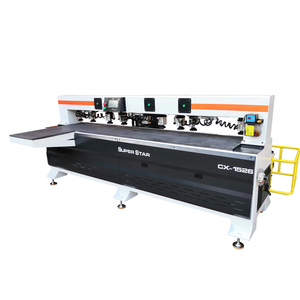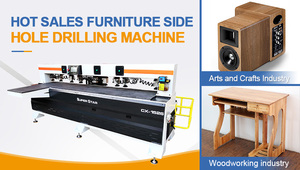
All categories
Featured selections
Trade Assurance
Buyer Central
Help Center
Get the app
Become a supplier

(1990 products available)



























Market Overview: The global market for circuit board drilling machines has been witnessing steady growth, attributed to the increasing demand for electronic devices and advancements in manufacturing technologies. According to Research and Markets, the market for associated machinery was estimated at USD 83.87 billion in 2023 and is projected to grow at a CAGR of 5.77%, reaching USD 124.23 billion by 2030. This growth is largely driven by the rising adoption of smart devices, which necessitate precise drilling processes for circuit boards. The Asia-Pacific region has emerged as a significant contributor to this market, bolstered by the concentration of semiconductor production and government incentives aimed at enhancing manufacturing capabilities. Countries like China and Japan are leading this growth trajectory, further influenced by the demand for high-quality electronic components.
Industry Insights: As consumer behavior shifts towards more sophisticated electronic products, manufacturers are increasingly investing in advanced circuit board drilling machines that enhance efficiency and precision. The integration of Industry 4.0 principles, including automation and IoT technologies, is revolutionizing production processes, allowing for greater customization and reduced downtime. However, challenges such as high initial investments and the need for skilled labor persist, potentially hindering market expansion. Notably, the competitive landscape sees a range of players focusing on innovation and sustainability, responding to the growing environmental consciousness among consumers and regulatory bodies. This focus on eco-friendly practices, coupled with the rising demand for microelectronics, positions the circuit board drilling machine market for sustained growth and resilience in the face of evolving industry dynamics.
A circuit board drilling machine, often called a drilled CNC machine, comes in various types, each with distinct features and capabilities. The following table summarizes some commonly known types of circuit board drilling machines.
Modern PCB drilling machines are equipped with advanced specifications for high-speed and accurate drilling. The specifications that buyers should focus on when purchasing include the drilling speed, diameter range, depth, precision, as well as the tool material and quality.
In order to maintain the drilling machine and ensure it functions properly, it is important to carry out regular inspection and cleaning. The electrical components, such as connectors, sensors and the control system should be checked regularly to ensure there are no loose connections. Also, any dust accumulation or debris on the air lines and pumps should be cleaned promptly. Users should also lubricate the moving parts of the machine to reduce wear and tear. Lubricate components like bearings, guide rails and drive systems with high-quality lubricants. Additionally, the drill bits should be inspected for signs of damage or wear. Depending on the board material being used, replace them if they are blunt or chipped. Finally, take time to calibrate the machine to ensure it meets the required parameters when drilling circuit board holes.
Circuit board drilling machines are designed to drill holes in printed circuit boards (PCBs) precisely. These machines play an important role in the PCB manufacturing process and offer a variety of applications.
First, these machines are used to create pathways for electrical connections between different components of a circuit board. They drill micro-holes or micro-vias where multiple layers of a PCB need to be interconnected. They are also used to drill mounting holes for PCB support or to mount electronic components. Besides, circuit board drilling machines are used to drill solder holes or pads where electronic components will be soldered. These holes are precisely drilled to ensure accurate placement and reliable soldering of the components.
Moreover, in PCBs that incorporate heat-sensitive elements or components, the circuit board drilling machine is used to drill thermal vias or holes to facilitate heat dissipation through the board. These holes allow heat to pass through the board, preventing overheating and ensuring proper functioning of the circuit.
Also, these machines are used to drill inspection and test holes on PCBs. The holes allow access to specific points on the circuit board for testing, probing or inspecting attributes like electrical connectivity.
More importantly, circuit board drilling machines are used in electronics manufacturing industries such as telecommunications, automotive, consumer electronics, medical devices, aerospace and military applications. In these industries, manufacturers create complex circuit boards with precision and high efficiency.Decision-making holes on a PCB can be a time-consuming and tedious task if done manually. However, with the use of drilling machines, this process becomes quicker, easier and more accurate.
Both manual and automatic PCB drilling machines have their respective uses in the industry because of varying needs. The following parameters can help buyers choose a valuable drilling machine:
Q1. How many types of drill bits are there for circuit board drilling machines?
A1.Up to five types of drill bits can be used with circuit board drilling machines. These include PCD micro-percussion bits, micro-percussion carbide bits, tungsten carbide spiral bits, diamond-coated carbide bits, and high-speed steel bits.
Q2. What are some advantages of laser circuit board drilling machines?
A2.Laser drilling machines have no physical tool. They provide high-precision drilling, high-speed operation, high automation, and flexibility. Laser drilling machines are suitable for complex designs and rapid prototyping. They also have low or no tool wear.
Q3. What are some disadvantages of laser circuit board drilling machines?
A3.The main disadvantages of machines that use a laser are their high cost. They also have limitations on material thickness and require additional cooling and gas removal systems.
Q4. What is the difference between a CNC and a laser circuit board drilling machine?
A2.CNC machines are less expensive than laser machines and have wider material compatibility. However, they provide lower precision and speed. The choice between the two machine types will depend on the user's specific needs and preferences.